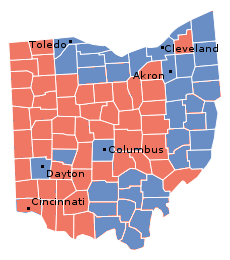This is the third part of a series of posts analyzing the swing state Ohio. The last part can be found here.
Swing Ohio
Like most states, Ohio contains several swing areas. Some lean Democratic; others lean Republican. A good politician will usually pick up most of these regions on his or her way to victory.
The following map provides a sense of swing Ohio.

Continued below the fold.
Providing balance, the map encompasses two solid Democratic victories and two solid Republican victories. Bearing this in mind, one can readily make out the structural ‘7’ of Ohio politics. Absent three counties, swing Ohio roughly encompasses the outer edges of Ohio’s northern and eastern borders, creating a shape that resembles the number ‘7.’ Strong Democrats win these swing counties and fatten the ‘7.’ Strong Republicans do the inverse.
Let’s look again at Bill Clinton’s 1996 victory.

As noted previously, Clinton is creating a fat ‘7’ in his re-election.
There are several other things that should be observed about Clinton’s victory with regard to swing Ohio. At the bottom of the state, Clinton is winning a group of thinly populated, Appalachian counties. One of these counties is Athens County, home to Ohio University; it is reliably liberal due to the college. The rest lean Republican. A strong traditional Democrat can and often will win southeast Ohio; if this happens, his Republican opponent is probably going down to defeat.
Bill Clinton is also winning three counties surrounded by red. One of these – Dayton – is the Democratic equivalent of southeast Ohio: it leans Democratic but will occasionally turn up on the other side. In that case the Republican will soon be receiving a concession call.
The other two counties are moving in opposite directions. In Clinton’s day, Clark County – Springfield – and Columbus were two cities squarely in Ohio’s swing category. Since then, however, Springfield has been drifting right: Gore won the county, Kerry and Obama lost it. Meanwhile, Columbus has been doing a hard swing left, so that neither it nor Springfield are swing regions anymore.
Finally, one may note that many places I define as “swing” are colored light red, rather than purple in the first map. This was because of Barack Obama’s peculiar performance in Ohio. The president won the state with an unconventional coalition: he lost much of swing Ohio and made up for it by performing extremely well in Columbus, Cincinnati, and northern Ohio. Whether this coalition was unique to 2008 or foreshadows a structural shift in Ohio is unknown. Personally, I prefer the former explanation.
–Inoljt, http://http://mypolitikal.com/